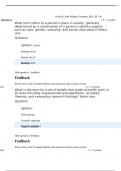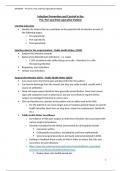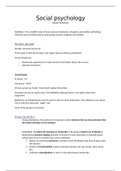PROJECTPLAN
TANZANIA
2020
10 JANUARY
Ilse van Verseveld & Charlotte Strik
596089 - 594815
,CONTENTS
Introduction ............................................................................................................................................................ 2
Tanzania .................................................................................................................................. 2
Question and aim(s) ................................................................................................................. 2
Needs assessment ................................................................................................................... 4
Health and project objectives ................................................................................................... 7
Visualising ................................................................................................................................ 7
Phase project ........................................................................................................................... 8
Research methods ................................................................................................................... 8
Conclusion ............................................................................................................................... 9
Discussion .............................................................................................................................. 10
Bibliography ........................................................................................................................... 11
Appendices ............................................................................................................................ 15
Behavioural change ................................................................................................................................... 15
Progression pressure ulcers ..................................................................................................................... 16
Guideline for ORU ...................................................................................................................................... 20
Moral and intercultural sesitivity ............................................................................................................... 24
Reflection on professional growth ............................................................................................................ 24
Reflection on personal growth .................................................................................................................. 25
Ilse van Verseveld & Charlotte Strik 1
596089 - 594815
, INTRODUCTION
Tanzania
Tanzania is a country in East Africa. In Tanzania they speak over 100
different languages and the official languages are English and Swahili. There
are three main cultures; Christian, Islamic and Animist. According to the World
Health Organization (WHO, 2016) the total population of Tanzania is
55.572.000 people. The life expectancy at birth for males is 62 years and for
females 66 years. The total expenditure on health as % of GDP is 5.6 Figure 3. United republic of Tanzania,
retrieved from WHO (2019) from
(WHO, 2016). https://www.who.int/countries/tza/en/
The main subject of our project plan is to improve the care for paraplegia
patients with pressure ulcers. We found a blog from a Dutch doctor who lives in Moshi
(Tanzania) about the healthcare in the hospital where we do our internship (Zwetselaar &
Dekker, 2019). In the blog she wrote that improvement is needed for the care of paraplegia
patients, especially with pressure ulcers. We cannot solve this problem in a short space of
time, but we can make a start by concentrating on this particular issue.
Question and aim(s)
Description of the target group:
The target group that we are going to investigate are the nurses at KCMC, who take care of
the paraplegia patients. We chose this target group because we have read on an online blog
from a Dutch neurologist that there is no neurological study in Tanzania (Zwetselaar &
Dekker, 2019). As a result, we expect that there is little to no knowledge about neurological
disorders and their consequences. We want to investigate this through the behaviour change
model. (Appendix 1.)
Setting
We want to conduct this research at the places where the paraplegia patients are in hospital
(KCMC). We want to see what the difference is between care for paraplegia patients in
Tanzania and the Netherlands and whether we can improve healthcare. We also studied
literature to be able to do this research. We do an internship in the spinal cord department.
There are two departments. We are doing an internship at the Orthopaedic Rehabilitation
Unit. This department can accommodate 12 male and 6 female patients. The majority are
male patients. There are almost no female patients. Many patients have one or more
pressure ulcers. The size of an average pressure ulcer in patients on the ORU is 10cm. Most
pressure ulcers are around the buttocks area.
The majority of patients arrive at the ORU with
pressure ulcers. This is because they arrive from a
different ward where they have had surgery. In other
departments no attention is paid to the occurrence
of pressure ulcers. In our department we deal with
the care of those pressure ulcers several times a
day. On figure 4. you can see the ORU's daily
routine. As you can see in figure 4, the day starts
with wound care (dressing) and the patients are
being turned by the nurses every two hours.
Figure 4. Daily routine for ORU ward by Charlotte
Ilse van Verseveld & Charlotte Strik 2
596089 - 594815
TANZANIA
2020
10 JANUARY
Ilse van Verseveld & Charlotte Strik
596089 - 594815
,CONTENTS
Introduction ............................................................................................................................................................ 2
Tanzania .................................................................................................................................. 2
Question and aim(s) ................................................................................................................. 2
Needs assessment ................................................................................................................... 4
Health and project objectives ................................................................................................... 7
Visualising ................................................................................................................................ 7
Phase project ........................................................................................................................... 8
Research methods ................................................................................................................... 8
Conclusion ............................................................................................................................... 9
Discussion .............................................................................................................................. 10
Bibliography ........................................................................................................................... 11
Appendices ............................................................................................................................ 15
Behavioural change ................................................................................................................................... 15
Progression pressure ulcers ..................................................................................................................... 16
Guideline for ORU ...................................................................................................................................... 20
Moral and intercultural sesitivity ............................................................................................................... 24
Reflection on professional growth ............................................................................................................ 24
Reflection on personal growth .................................................................................................................. 25
Ilse van Verseveld & Charlotte Strik 1
596089 - 594815
, INTRODUCTION
Tanzania
Tanzania is a country in East Africa. In Tanzania they speak over 100
different languages and the official languages are English and Swahili. There
are three main cultures; Christian, Islamic and Animist. According to the World
Health Organization (WHO, 2016) the total population of Tanzania is
55.572.000 people. The life expectancy at birth for males is 62 years and for
females 66 years. The total expenditure on health as % of GDP is 5.6 Figure 3. United republic of Tanzania,
retrieved from WHO (2019) from
(WHO, 2016). https://www.who.int/countries/tza/en/
The main subject of our project plan is to improve the care for paraplegia
patients with pressure ulcers. We found a blog from a Dutch doctor who lives in Moshi
(Tanzania) about the healthcare in the hospital where we do our internship (Zwetselaar &
Dekker, 2019). In the blog she wrote that improvement is needed for the care of paraplegia
patients, especially with pressure ulcers. We cannot solve this problem in a short space of
time, but we can make a start by concentrating on this particular issue.
Question and aim(s)
Description of the target group:
The target group that we are going to investigate are the nurses at KCMC, who take care of
the paraplegia patients. We chose this target group because we have read on an online blog
from a Dutch neurologist that there is no neurological study in Tanzania (Zwetselaar &
Dekker, 2019). As a result, we expect that there is little to no knowledge about neurological
disorders and their consequences. We want to investigate this through the behaviour change
model. (Appendix 1.)
Setting
We want to conduct this research at the places where the paraplegia patients are in hospital
(KCMC). We want to see what the difference is between care for paraplegia patients in
Tanzania and the Netherlands and whether we can improve healthcare. We also studied
literature to be able to do this research. We do an internship in the spinal cord department.
There are two departments. We are doing an internship at the Orthopaedic Rehabilitation
Unit. This department can accommodate 12 male and 6 female patients. The majority are
male patients. There are almost no female patients. Many patients have one or more
pressure ulcers. The size of an average pressure ulcer in patients on the ORU is 10cm. Most
pressure ulcers are around the buttocks area.
The majority of patients arrive at the ORU with
pressure ulcers. This is because they arrive from a
different ward where they have had surgery. In other
departments no attention is paid to the occurrence
of pressure ulcers. In our department we deal with
the care of those pressure ulcers several times a
day. On figure 4. you can see the ORU's daily
routine. As you can see in figure 4, the day starts
with wound care (dressing) and the patients are
being turned by the nurses every two hours.
Figure 4. Daily routine for ORU ward by Charlotte
Ilse van Verseveld & Charlotte Strik 2
596089 - 594815







